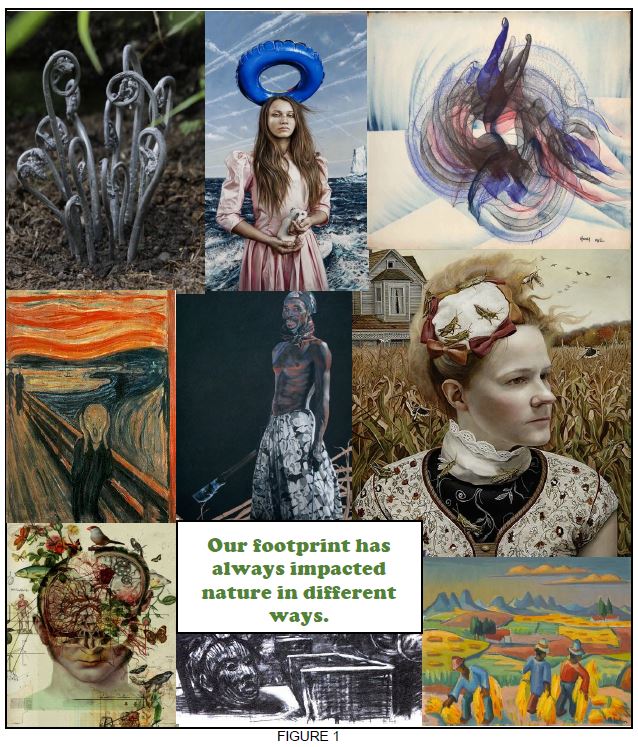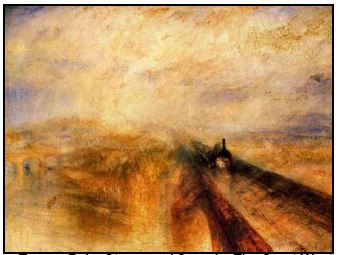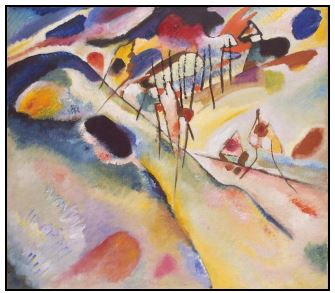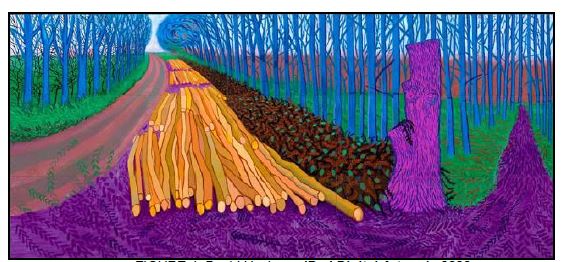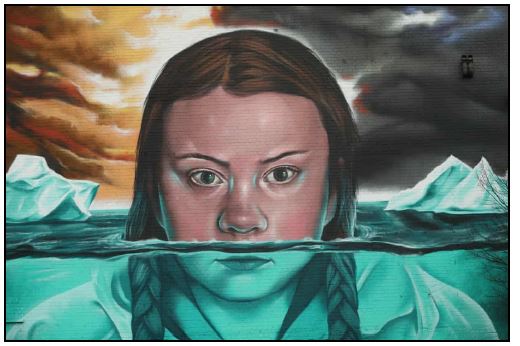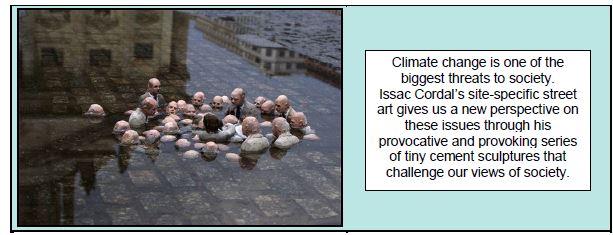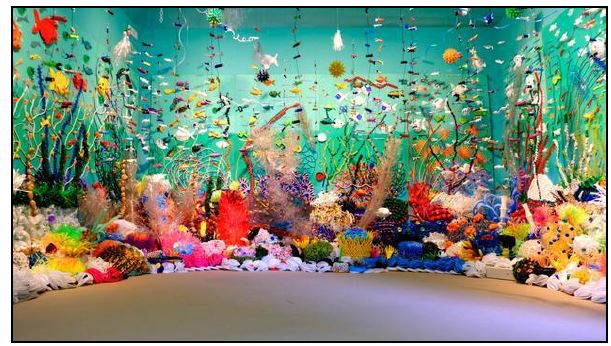VISUAL ARTS PAPER 2 GRADE 12 QUESTIONS - NSC PAST PAPERS AND MEMOS NOVEMBER 2021
Share via Whatsapp Join our WhatsApp Group Join our Telegram GroupINSTRUCTIONS AND INFORMATION
- This question paper consists of TWO sections:
TOPIC 1: SOURCEBOOK
TOPIC 2: ARTWORK - Answer ALL the questions in TOPIC 1 and TOPIC 2.
- Your teacher must introduce and facilitate this examination.
- In this examination you will be expected to demonstrate the following skills:
- Apply advanced approaches independently and creatively and generate ideas in response to a project brief.
- Demonstrate an advanced degree of technical skill in the use of a range of materials and techniques.
- Solve visual and conceptual problems with the creation of imaginative and innovative artworks, using a personal, expressive visual language.
- Manage time and the working process effectively and present own work in a professional manner that enhances the expressive and conceptual impact of the work.
- Your final practical examination in Grade 12 represents the culmination of your art studies this year. Your creativity, originality and skill will be displayed. May you enjoy creating this artwork and may it be fresh and original, and communicate personal experience.
TOPIC 1: SOURCEBOOK (Conceptualised by the development and realisation of creative ideas)
The sourcebook provides insight into how you have formed ideas, how many alternatives you have investigated and other processes leading to the final work. The sourcebook should clearly communicate all thought processes leading to the making of the artwork.
You should visually tell the 'story' of how your artwork was conceived, developed and produced through drawing, experimentation and writing. It should reflect your individuality and creativity as a Visual Arts candidate.
The sourcebook forms an important part of this examination. You may work on it at school and/or at home. It provides insight into the way you form ideas, how many alternatives you have investigated, as well as other processes leading to the final work.
Clearly mark this sourcebook as examination work and present it with your final artwork, TOPIC 2. Direct copying from magazines, the internet, etc. is NOT allowed. Direct copying of an image that is not your own, WILL BE PENALISED. This is a form of plagiarism and is unacceptable. The process of TRANSFORMATION of the source material is of utmost importance. If you need to use appropriate borrowed images, you must combine them with your own original images TO DEVELOP YOUR OWN INTERPRETATION. |
The sourcebook is part of your creative journey to develop the final artwork. It must reflect your creativity as an art candidate by being aesthetically exciting and creative in the presentation thereof.
Your teacher must facilitate the initial brainstorming and will help guide you in your creative process.
TOPIC 2: THE ARTWORK (The making of creative artworks, the management of the process and presentation, following safe practice)
The examination work must be done in the presence of the Visual Arts teacher within the confines of the art room, within a minimum of 12 hours and a maximum of 24 hours.
GENERAL GUIDELINES
- You are required to produce ONE artwork in the practical discipline that you have chosen this year.
- You may present your artwork as a single piece or possibly in the form of a diptych, triptych or a series of works that read as one artwork.
- You may NOT take the artwork out of the examination venue. This is regarded as an examination irregularity.
- You have to discuss the question paper with your Visual Arts teacher PRIOR to starting the final artwork.
- There are no restrictions on size, but the artwork must be manageable and durable in terms of transportation to the examination centre, if required by the province.
- Remember the importance of the elements and principles of art, such as line, shape, colour, texture, space, rhythm, balance, harmony, proportion and composition.
- There are no specific prescriptions regarding the style of the work. It may be naturalistic, expressionistic, decorative, etc.
- Select imaginative subject matter, themes, symbols and metaphors to create an expressive, emotional, conceptual or perceptual artwork.
- You may incorporate other media to create mixed-media work in any of the practical disciplines.
- Continue working and annotating in your sourcebook up until the end of the 24-hour examination, which will allow for final changes and ideas. The process is important as it will allow you to explain and record your success and shortcomings during the examination.
THEME
FOOTPRINT
OUR FOOTPRINT HAS ALWAYS IMPACTED NATURE IN DIFFERENT WAYS We are surrounded by nature and interact with it every day. The most intimate part of nature in relation to us is the biosphere, an envelope embracing the earth, its soil cover, and everything else that is alive. We are always aware of the influence of nature in the form of the air we breathe, the water we drink and the food we eat. Our troubles and difficulties are due to the natural processes and changes in the weather caused by our interference. Over the centuries artists have been fascinated by depicting nature and landscapes. |
FIGURE 2: William Turner, Rain, Steam and Speed – The Great Western Railway, oil on canvas,1844.
FIGURE 3: Wassily Kandinsky, Landscape, oil on canvas, 1913. He used nature as a starting point for his paintings, which focused on spirituality in art.
FIGURE 4: David Hockney, iPad Digital Artwork, 2020.
FIGURE 5: David Hockney, A Bigger Picture, iPad digital artwork, 2020.
FIGURE 6: Jody Thomas, Mural of Greta Thunberg, photograph by Andrew Matthews, date unknown.
Greta Thunberg, a climate activist launched 'Fridays for Future' (School Strike for Climate in 2018) where she went on strike demanding action on climate change.
Due to climate change many things will be affected in nature, namely a warmer planet, changing weather patterns, ocean acidification, rising sea levels, hurricanes, flooding, thunderstorms and blizzards resulting in the species we depend on for food being at risk of extinction.
FIGURE 7
FIGURE 8: Isaac Cordal, Politicians Debating Global Warming, site-specific sculpture, cement, 2011.
FIGURE 9: Federico Uribe's Personal Structures, 2019, was inspired by conservation and plastic pollution. Uribe has repurposed unusual objects and materials, such as bullet shells, coloured shoelaces, pins, pencils, electrical wires, ties and books to create a coral reef installation. From a distance the assemblages appear to be beautiful, colourful underwater worlds, reminding us of the fragility of life. Plastic production is unstoppable and according to the World Economic Forum, the world is now producing more than 300 million tons of plastic every year. Only 40 per cent is used once and more than 8 million tons of plastic are dumped into the ocean every year.
You must create an artwork in which you share your personal view(s) of Footprint
In the sourcebook you should VISUALLY tell the story of how the final Artwork was CONCEIVED, DEVELOPED and PRODUCED. This should be done through drawing, writing, pasting, photographs, etc. This journey in the sourcebook should reflect individuality and creativity. With the final artwork you will be able to show ideas, emotions and thoughts of your individual interpretation of the theme: Footprint
Consider the following as an inspiration/idea for your final artwork
- Our footprint and relationship with nature
- Our relationship with beauty in nature
- How we can protect and nurture nature
- How we control and manipulate nature
- How we have used nature to our advantage
- How we have exploited nature
- The significance of a garden as both a physical and or symbolic place of refuge
- Your interpretations of how man has either destroyed or conserved/preserved nature
- How we protect and preserve our planet for future generations
- Pollution and its effects on our planet
- How industrialisation has changed our landscape over the centuries
- What we can do to create awareness of the dangers of pollution/global warming
- How we up-cycle, recycle, re-use, manipulate and repurpose material
- How have we used new found/unusual materials to create innovative solutions/products/sculptures, e.g. plastic packets are used to create paintings and bags
- You may refer to the elements in nature, namely air, wind, water, fire and earth
Consult your teacher if you are unsure about controversial imagery:
- All visual imagery/artworks should be in line with your school's code of conduct
- Be mindful of sensitive images and issues in all cultural practices
TOPIC 1: SOURCEBOOK/WORKBOOK (Conceptualising through the development and realisation of creative ideas)
- The assessment criteria descriptions will guide you in the unpacking of your idea. See that you give a PERSONAL response and stay away from clichéd ideas.
- Your sourcebook must relate to the final artwork.
TOPIC 2: THE ARTWORK
- It is important to create an artwork that is exciting, original, current and honest.
ASSESSMENT CRITERIA FOR PRACTICAL WORK
| Outstanding | 90–100 |
|
| Excellent | 80–89 |
|
| Very good | 70–79 |
|
| Good | 60–69 |
|
| Average | 50–59 |
|
| Below average | 40–49 |
|
| Weak | 30 - 39 |
|
| Very weak Fail | 20–29 |
|
| Unacceptable Fail | 0–19 |
|
TOPIC 1: SOURCEBOOK
| ASSESSMENT CRITERIA | This includes the following: | Suggested mark allocation |
| Concept development | Mind maps, annotated sketches and drawings to show concept development | 25% |
| Research, investigation, experimentation, etc. |
| 25% |
| Process drawings |
| 25% |
| Presentation and overall view |
| 25% |
| TOTAL | 50 |
TOPIC 2: THE ARTWORK
| ASSESSMENT CRITERIA | This includes the following: | Suggested mark allocation |
| Choice and use of materials/techniques |
| |
| Use of formal art elements |
| |
| Overall impression of work – originality, creativity, innovation |
| |
| Interpretation and practical implementation of research |
| |
| Completion and presentation of artwork |
| |
| TOTAL | 50 |
I declare that the attached NSC practical examination is all my own work and does not include any work completed by anyone other than myself. I have completed the examination in accordance with the instructions and time limits.
| DECLARATION OF AUTHENTICITY | |
| This declaration must be completed and signed by the candidate and countersigned by the teacher and cover all evidence submitted. | |
| Candidate's name: | Date: |
| I declare that the attached NSC practical examination is all my own work and does not include any work completed by anyone other than myself. I have completed the examination in accordance with the instructions and time limits. | |
| Candidate's signature: | Date: |
| Teacher's name: | Date: |
| On behalf of ……………………………………………………………………. (centre name), I confirm that, to the best of my knowledge, the above-mentioned candidate is the sole author/artist of the completed work attached, which has been completed under the required conditions. | |
| Teacher's signature: | Date: |
| School principal's signature: | Date: |
ADDENDUM A
- The candidate is required to produce ONE artwork in the PRACTICAL OPTION that he/she HAS CHOSEN THIS YEAR. Specialised options include drawing, painting, sculpture, printmaking, multimedia work, photography, installations, new media, etc.
- Some candidates need the freedom to work across disciplines. This is in keeping with contemporary art practices. A specialised focus on painting could include the exploration of three-dimensional work and new media.
- Candidates' artworks are marked according to the criteria for the subject Visual Arts, and not according to the specialised discipline, e.g. painting and photography. In all specialised options there should be a balance between technical (form) and conceptual (content) aspects within the selected approach. The candidate's intention towards and approach to both the technical and conceptual aspects of the work should be considered when assessing the artwork(s).
- Contemporary artists pull from an infinite variety of materials, sources and styles to create art. Contemporary artists working in the Postmodern Era embrace the notion of 'artistic pluralism', the acceptance of a variety of artistic intentions and styles.
- Today's contemporary art world shows a cross-over/integration of media/ technique, which means our pre-conceived ideas and techniques are constantly changing. Practical work should always be informed by contemporary art practice. This must be kept in mind when marking examination work.
- Creativity and individuality should be stressed.
ADDENDUM B: GUIDELINES FOR NEW MEDIA/MULTIMEDIA/DIGITAL ART, ETC.
According to the Curriculum and Assessment Policy Statement (CAPS) teachers should not be prescriptive about specialised disciplines, such as darkroom photography, printmaking, drawing and sculpture. Teachers should consult the CAPS document for guidance along with referencing traditional utilisation and contemporary fine art practices in these disciplines. Below are general guidelines for the grey areas in contemporary disciplines: new media/multimedia/digital art, etc.
Working in new media/multimedia/digital art does NOT guarantee high marks.
SOURCEBOOK: NEW MEDIA/MULTIMEDIA/DIGITAL ART, ETC.
- Concept development and realisation must play an important role in all new media/multimedia/digital work. Evidence of the candidate's thought processes leading to the final realisation of the concept in his/her work should be visually evident.
- The sourcebook must show evidence of:
- Relevant source material – own sources generated with the use of software or created by hand and digitised through various input devices
- Concept development (thumbnail sketches, writing and/or a storyboard)
- Research on artists following similar approaches
- Documentation of programs used, e.g. screenshots
- A minimum of 30% should be drawings to explain concept development. It must show evidence of hand skills.
ARTWORK: NEW MEDIA/MULTIMEDIA/DIGITAL ART, ETC.
- All new media art must emphasise artistic voice over technical skill. In other words, it is not the skill of the candidate in a specific computer program that is assessed, but the aesthetic use thereof. Therefore, research of contemporary artists is vital to create an own artwork. (Candidates must distinguish between using these new types of media to create art, as opposed to design, e.g. music videos.)
- Using computer applications as a tool to realise concept, expressive and formal concerns (similar to how a painter would use his brush and paint)
- Candidates must consider conceptual, aesthetic, expressive and formal concerns as fundamental to the approach, including sensitivity to context.
- Personal control and execution of work
- Presentation is important:
- In art galleries and museums, video art and animations are usually presented in a large format to engulf the viewer with a total sensory experience. Although this is not possible in most schools, the candidate must consider the impact of the work on a computer screen.
- In two-dimensional digital work the final artwork cannot be only an A4 print. It has to be a series of at least THREE A4 works that relate in narrative OR printed in A2 and mounted.
- In animation/video art consideration must be given to space, time, movement, narrative, chronology, interaction of image and sound.
- Candidates must consider the soundtrack in animation/video art carefully. Often the soundtrack gives a 'music video' feel to the work and contradicts the message. Candidates can create their own sounds.
DIGITAL PHOTOGRAPHY
- The minimum requirement is FOUR A4-related digital prints OR something similar in size, e.g. THREE A3 prints or ONE A2 or larger print.
- The photographs should be conceptualised and presented as ONE artwork, e.g. follow a narrative.
- Place the digital images on a CD into the front of the sourcebook. All digital software procedures must be documented thoroughly in the sourcebook. The candidate must keep a record of screenshots that illustrate all the editing decisions made. This is the only way to validate digital work as authentic, since so much digital artwork is available for download on the internet. Teachers must monitor the development of the candidate's digital process.
- The sourcebook must include the following:
- The program used (e.g. Adobe Photoshop 7 ©)
- All digital software procedures. The candidate must keep a record of screenshots that illustrate all the editing decisions made.
- The tools the candidate used to manipulate his/her images, in other words, adjustments made, filters used (distort, noise, render, sketch), etc.
- Candidates should consider the presentation of the work carefully.
- Candidates selecting this option must familiarise themselves with contemporary developments in fine art digital photography.
- Photography, both traditional and digital, is not only a technical exercise, but also encompasses questions of aesthetics, intent, content, etc. in the assessment criteria.
- Do all manipulation and changes to the photographs during the 24 hours of the examination. Presentation needs to be resolved in the 24 hours.
Assessment of photography:
- Interpretation and communication of the theme is important. Candidates should be able to compose and establish relationships between images.
- The work must reflect a high degree of originality and strong creative qualities. It should read as fine art, therefore conceptualisation in the sourcebook is essential.
- Images must relate to one another and the theme. No random selection.
- Formal elements and principles.
- Photography may be combined with other media.
- Consider presentation of your photographs.
INSTALLATION
- Installations break away from traditional painting and sculpture by creating three-dimensional spaces that viewers can enter and be surrounded by an artist's processes and visions. An environment is created by arranging objects in space, and environments that change or enhance the space itself.
It should be in line with contemporary developments in fine art practices. - Two and three-dimensional elements within an environment.
- Candidates may use ready-mades.
- Viewer interaction with space is important.
- Sensitivity to viewer reception and interaction on multiple sensory levels.
- Installation artworks must be resolved fully, both technically and conceptually. There should be extensive research and concept development in the sourcebook to justify the artwork.
PERFORMANCE ART
- Performance pieces must be planned, documented and rehearsed thoroughly.
- Make drawings throughout the process of conceptualising the performance.
- Document the performance photographically, videographically and with drawings and words.
- Pay careful attention to the subtle differences between Performance Art as Visual Art and Performance Art as Dramatic Art.
- For the final examination the documentation of the performance will be assessed and not the actual performance due to the nature of the examination and moderation process.
